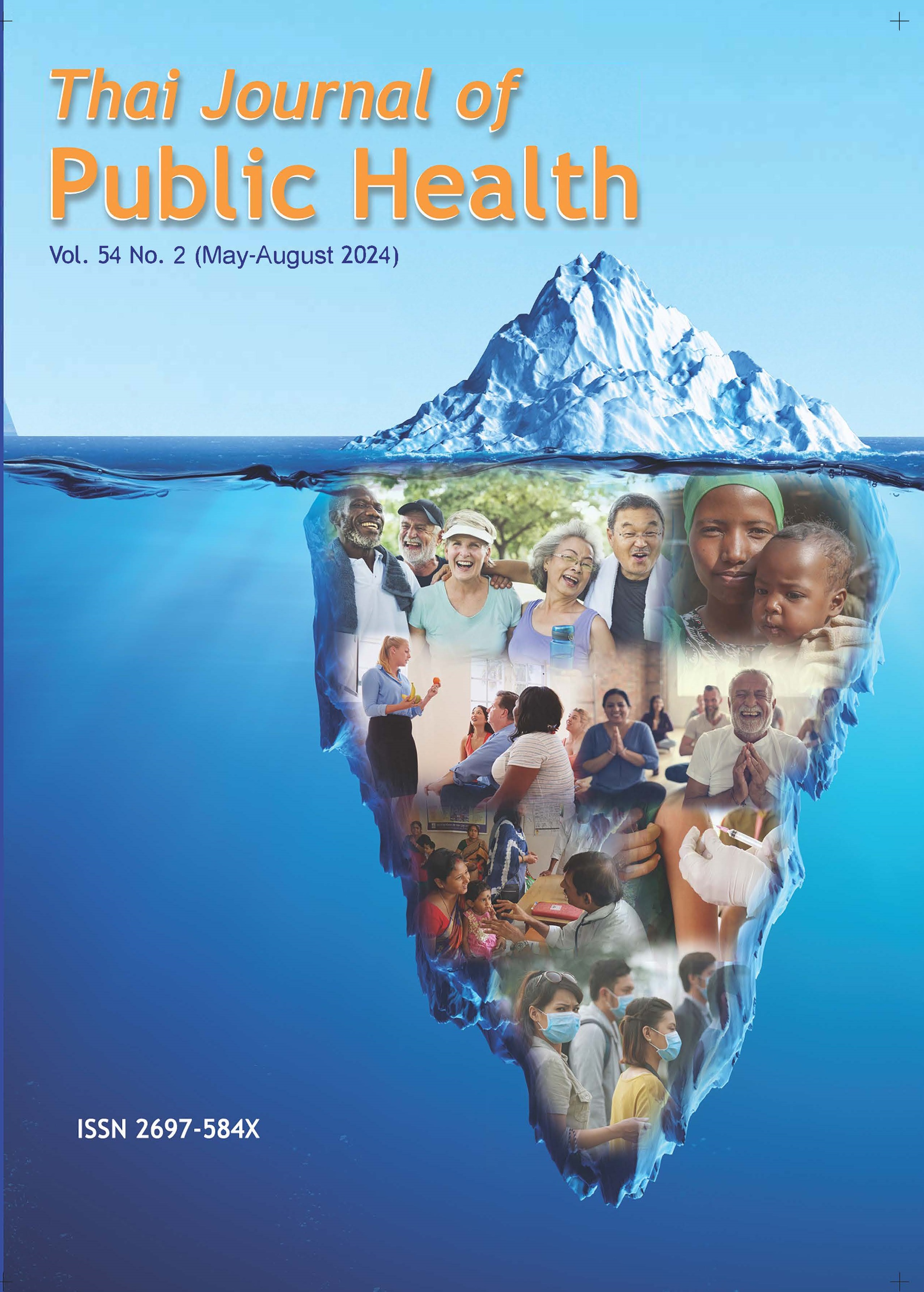Prevalence of Noncommunicable Diseases and Social Determinants of Health in Thailand: Insights from Public Datasets
Keywords:
Noncommunicable diseases, Social determinants of health, Public datasets, Prevalence, Descriptive analysisAbstract
This review delved into publicly available datasets to scrutinise Noncommunicable Diseases (NCDs) and Social Determinants of Health (SDHs) in Thailand from 2013 to 2021. The causality between NCDs and SDHs lies in how socioeconomic factors, environmental conditions, and access to healthcare significantly influence the distribution of NCDs risk factors and health outcomes, exacerbating health disparities and shaping individual behaviors that contribute to NCD development. NCDs prevalence studied include cancer (CA), coronary artery disease (CAD), chronic obstructive pulmonary disease (COPD), diabetes mellitus (DM), hypertension (HTN), and stroke. SDHs data encompassed household income, expenses, loans, education, smokers, alcohol consumers, and particulate matter 2.5 levels. Descriptive analysis was employed to scrutinize publicly available datasets. Findings revealed significant increase in household incomes, loans, and PM2.5 concentrations, posing environmental risks. NCDs prevalence rates, including DM, HTN, Stroke, CAD, CA, and COPD, exhibited upward trends. Provincial disparities in NCD prevalence underscored the necessity for targeted interventions. Future research may focus on longitudinal trends in SDHs. To mitigate escalating NCDs prevalence, comprehensive health promotion programs are imperative, emphasizing risk factor awareness, lifestyle changes, and enhanced access to preventive healthcare services. Investigating provincial disparities and socioeconomic factors impacting health outcomes is vital for policy formulation.
References
Aekplakorn W, Chongsuvivatwong V, Tatsanavivat P, Suriyawongpaisal P, Putwatana P. Trends in overweight and obesity in Thailand. Obesity Reviews. 2009; 10(6): 543-54. DOI: 10.1111/j.1467-789X.2009.00584.x
Institute for Health Metrics and Evaluation. GBD Compare. Available from: https://vizhub.healthdata.org/gbd-compare/, accessed 10 Dec, 2022.
Kazibwe J, Tran PH, Annerstedt KS. The household financial burden of non-communicable diseases in low- and middle-income countries: a systematic review. Health Research Policy and Systems. 2021; 19(1). DOI: 10.1186/s12961-021-00732-y
Khunakorncharatphong A, Pudpong N, Suphanchaimat R, Julchoo S, Phaiyarom M, Sinam P. Noncommunicable Disease Service Utilization among Expatriate Patients in Thailand: An Analysis of Hospital Service Data, 2014–2018. International Journal of Environmental Research and Public Health. 2021;18(18): 9721. DOI: 10.3390/ijerph18189721
Marmot M, Bell R. Social determinants and non-communicable diseases: time for integrated action. BMJ. 2019; l251. DOI: 10.1136/bmj.l251
Ministry of Public Health of Thailand. Open Data by MOPH. Available from: https://opendata.moph.go.th/th/main, accessed 10 Sep, 2022.
National Statistical Office Thailand. National Statistical Office Thailand. Available from: http://www.nso.go.th/, accessed 10 Sep, 2022
Nawamawat J, Prasittichok W, Prompradit T, Chatchawanteerapong S, Sittisart V. Prevalence and characteristics of risk factors for non-communicable diseases in semi-urban communities. Journal of Health Research. 2020; 34(4): 295–303. DOI: 10.1108/jhr-03-2019-0058
Pollution Control Department. Air4Thai. 2022 Dec 14. Available from: http://air4thai.pcd.go.th/webV2/region.php?region=0
Potempa K, Rajataramya B, Singha-Dong N, Furspan P, Kahle E, Stephenson R. Thailand's Challenges of Achieving Health Equity in the Era of Non-Communicable Disease. Pacific Rim international journal of nursing research. 2022; 26(2): 187–97.
Reap M, Pornwattanavate S, Thame C, Van Der Putten M. The social determinants of health of the Urak Lawoi’ of southern Thailand. BMC Public Health. 2020; 20(1). DOI: 10.1186/s12889-020-8283-y
World Health Organization. Social determinants of health. 2019 May 30. Available from: https://www.who.int/health-topics/social-determinants-of-health, accessed 11 Sep, 2011.
Health.gov. Social Determinants of Health - Healthy People 2030. Available from: https://health.gov/healthypeople/objectives-and-data/social-determinants-health, accessed 31 Mar, 2023.
Stringhini S, Carmeli C, Jokela M, Avendaño M, McCrory C, d’Errico A, et al. Socioeconomic status, non-communicable disease risk factors, and walking speed in older adults: multi-cohort population based study. BMJ. 2018; k1046. DOI: 10.1136/bmj.k1046
Tankumpuan T, Asano R, Koirala B, Dennison-Himmelfarb C, Sindhu S, Davidson P. Heart failure and social determinants of health in Thailand: An integrative review. Heliyon. 2019; 5(5): e01658. DOI: 10.1016/j.heliyon.2019.e01658
United Nations. THE 17 GOALS | Sustainable Development. Available from: https://sdgs.un.org/goals, accessed 15 Oct, 2022.
The Ministry of Public Health of Thailand. The Ministry of Public Health of Thailand. 2016 Nov 1. Available from: https://hss.moph.go.th/fileupload_doc_slider/2016-12-01--431.xls, accessed 12 Dec, 2022.
United Nations. Transforming our world: the 2030 Agenda for Sustainable Development. Available from: https://sdgs.un.org/2030agenda, accessed 11 Sep, 2022
World Bank. Current health expenditure (% of GDP) - Thailand | Data. Available from: https://data.worldbank.org/indicator/SH.XPD.CHEX.GD.ZS?locations=TH, accessed 11 Sep, 2022.
World Health Organization. A Conceptual Framework for Action on the Social Determinants of Health. 2010 Jul 13. Available from: https://www.who.int/publications/i/item/9789241500852, accessed 11 Sep, 2022.
World Health Organization. Global status report on noncommunicable diseases 2014. 2014 . Available from: https://apps.who.int/iris/handle/10665/148114, accessed: 11 Sep, 2022.
World Health Organization. Assessing National Capacity for the Prevention and Control of Noncommunicable Diseases: Global Survey, 2015. WHO Document Production Services, Geneva, Switzerland. 2016. Available from: https://www.who.int, accessed 11 Sep, 2022.
World Health Organization. Action plan for the prevention and control of noncommunicable diseases in the WHO European. 2016. Available from: https://apps.who.int/iris/handle/10665/341522, accessed 11 Sep, 2022.
World Health Organization. Global Health Estimates: Leading Causes of Death. Available from: https://www.who.int/data/gho/data/themes/mortality-and-global-health-estimates/ghe-leading-causes-of-death, accessed 11 Sep, 2022.
World Health Organization. Non-communicable diseases. 2022 Sep 16. Available from: https://www.who.int/news-room/fact-sheets/detail/noncommunicable-diseases, accessed 13 Oct, 2022.
Yadee J, Permsuwan U, Guntawongwan K, Himakalasa W, Buddhawongsa P. Discounting money and health effects from communicable and noncommunicable diseases in Thailand. Scientific Reports. 2023; 13(1). DOI: 10.1038/s41598-023-30559-2
Ministry of Public Health of Vancouver, World Health Organization, United Nations Development Programme, and United Nations Inter-Agency Task Force. (2021). Prevention and control of noncommunicable diseases in Vancouver – the case for investment. Retrieved from https://www.who.int/vancouver/activities/NCDs_Investment_Case_Report
Rasesemola RM, Mmusi-Phetoe R, Havenga Y. Social determinants of health in non-communicable diseases prevention policies in South Africa. Curationis. 2023 Jun 30; 46(1). Available from: https://doi.org/10.4102/curationis.v46i1.2387
Marmot M, Bell R. Social determinants and non-communicable diseases: time for integrated action. The BMJ. 2019 Jan 28; l251. Available from: https://doi.org/10.1136/bmj.l251
Downloads
Published
Issue
Section
License

This work is licensed under a Creative Commons Attribution-NonCommercial-NoDerivatives 4.0 International License.
Creative Commons License CC-BY-ND


